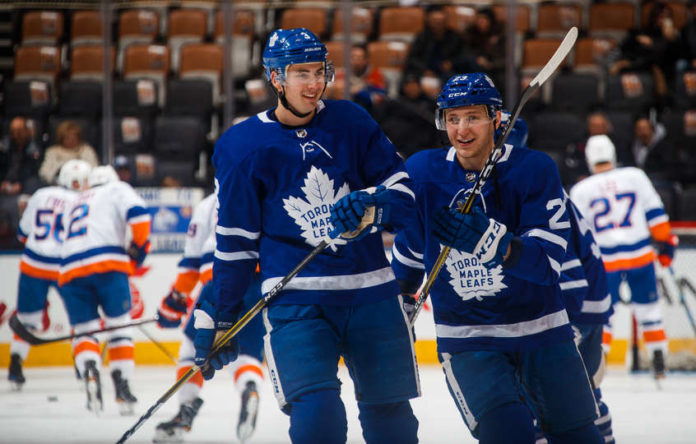
Many of us wondered if yesterday’s Jared McCann trade was going to change the Maple Leafs’ expansion draft protection list calculations, which had long been assumed to follow the 8+1 protection scheme in order to shield the following names from the selection process:
- Auston Matthews
- John Tavares
- Mitch Marner
- William Nylander
- TJ Brodie
- Morgan Rielly
- Jake Muzzin
- Justin Holl
- Jack Campbell
In the end, the plan remained the same, only now with both Alex Kerfoot and McCann exposed.
Here's the full list of who the Leafs protected and left unprotected, including UFAs, RFAs, Marlies. The Kraken, in theory, could claim Zach Hyman and hope to sign him. pic.twitter.com/mvUponxVAC
— Kevin McGran (@kevin_mcgran) July 18, 2021
What is unclear and won’t be known until Wednesday night during the expansion draft: whether the Leafs have any deals in place to steer Seattle towards a certain player, or if they’re accepting that they’ll lose one of Kerfoot or McCann — with some chance it is Travis Dermott — and are not going to overthink it by giving up an additional asset(s).
Kevin Papetti made an important point in this morning’s breakdown of the McCann trade: if Kyle Dubas knew Kraken GM Ron Francis may well be keen on McCann, losing Filip Hallander and a seventh-round pick to the expansion draft would pretty much be a shoulder shrug in terms of the assets lost to Seattle.
That won’t mean that the decision to go with eight skaters and a goalie in order to keep Justin Holl protected over Kerfoot, McCann, and Dermott won’t be hotly debated in Leafs circles.
What is definitely working in Holl’s favour: he’s paid $2 million for two more seasons, and he has established himself as a reasonably effective complement to Jake Muzzin on a capable shutdown pairing inside the Leafs’ top four. It’s going to be really difficult to find right-handed defensemen who can give the team solid minutes in this role who would be paid at a comparable rate for the next two seasons.
The counterargument is that Jake Muzzin can carry many partners who, in other contexts, may not necessarily be true top-four defensemen, which the 29-year-old Holl may well not be (perhaps more of a #5), and Holl did slow down in terms of his on-ice results at both ends as the season progressed after a good start to 2020-21.
Kerfoot, meanwhile, is paid $3.5 million for two more years, and while his stepping up in the playoff series vs. Montreal after John Tavares went down should not be lost on anyone, he played to 33-point pace last season over 82 games after 28 points in 65 games in his first year with the Leafs in 2019-20. He hasn’t been strictly limited to a bottom-six role, either, as he has received a number of stints up the lineup on the wing next to Tavares. For most of the regular season, Kerfoot felt essentially like “a guy taking shifts” in the Leafs‘ lineup, rarely leaping off of the page or making much of an impact game to game.
To be fair, Kerfoot has provided the Leafs with some value on the penalty kill and earned the trust of Sheldon Keefe in key defensive situations late in games. That said, if Kyle Dubas is doing his job well, the Leafs can probably find better value for their $3.5 million cap dollars if Kerfoot is indeed the Kraken’s selection — which has been the rumour for some time, albeit this was the assumption prior to the McCann acquisition.
The Holl vs. Kerfoot decision, for me, is pretty cut and dry. Holl is a right-handed defenseman who makes $2 million through 2022-23 and has given you reliable shifts inside the top four under tough assignments. You protect him over Kerfoot, and if Kerfoot goes, you look to squeeze more out of the $3.5 million in cap space in terms of scoring depth and overall utility than the Leafs have received out of Kerfoot.
The McCann trade yesterday means the Leafs already have a replacement who is more productive for over $500k less on the cap.
Now, the possibility of losing McCann makes the debate a little more interesting. Just 25 years old, he looks to be a pretty useful and efficient piece in terms of all of what he can provide for $2.95 million next season — he’s played both wings, down the middle, and consistently produced better than .5 points per game, including playing to a 61-point pace last season. That said, he’s not completely cost-controlled beyond 2021-22, after which he’ll be an arbitration-eligible RFA.
Again, if Dubas is doing his job well, I can see the logic for the Leafs going out and finding comparable production out of another forward (or two) with McCann’s $3 million this season if need be as opposed to protecting McCann and potentially needing to go out and replace Holl on the right side of their defense with cap space currently so tight.
The more I think about this, it's solid asset mgmt:
– SEA takes Kerfoot, TOR replaces him for a B prospect + 7th
-SEA takes McCann, TOR expansion loss is a B prospect + 7th
– SEA takes Dermott, TOR adds fwd depth + top4 D remains intact
These are all net positive scenarios.
— Garrett B (@garrettbauman) July 18, 2021
All of this said, we won’t have the full picture until any trades with Seattle are known, and, really, until the full offseason puzzle of moves comes into view. What does appear reasonably safe to assume at this point is that Kyle Dubas quite enjoyed having an above-average top-four on the blue line last season and doesn’t have much of an appetite for shuffling any of its pieces.
































